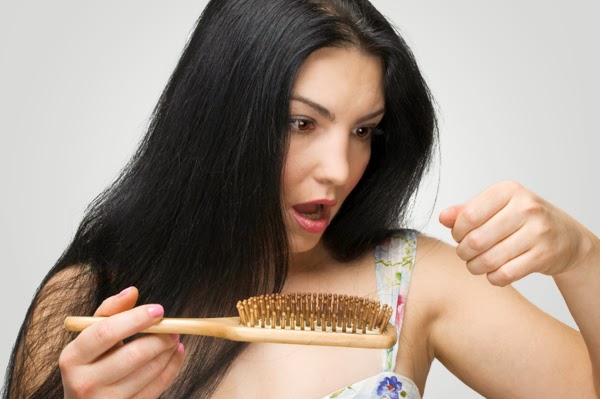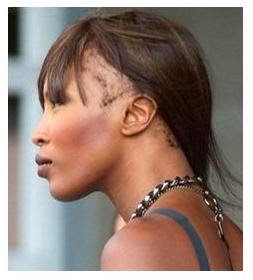Women face a lot in life and so do men. In the case of hair loss, every woman experiences hair loss at a point or another. When hair loss occurs, a lot of women freak out because they think it’s an infection or the start out of a deadly disease. But it’s not, in fact, most of the causes of loss of hair in women is treatable. A woman could experiences hair loss in the following occasions or reasons
According to Health.com, Pregnancy is an example of the type of physical stress that can cause hair loss (that and hormones). Pregnancy-related hair loss is seen more commonly after your baby has been born. If you do experience hair loss, rest assured that your hair will grow back in a couple of
months. Normally, you lose about 100 to 125 hairs a day, but after delivery, you may be losing about 500 a day. This can be very disturbing, but try not to worry too much — you won’t go bald! According to babycenter.com, If the hair loss doesn’t seem to be slowing and you’re still losing lots of hair six or so months after delivery, check in with a dermatologist or your healthcare provider. It may be a sign that you’re low on iron, which is not entirely uncommon for new moms. Hair loss in pregnancy is very natural in women, which is why it’s number one on the women’s corner… for women.
Any kind of physical trauma—surgery, a car accident, or a severe illness, even the flu—can cause temporary hair loss. Hair loss often becomes noticeable three-to-six months after the trauma. Sudden weight loss is a form of physical trauma that can result in thinning hair. This could happen even if the weight loss is ultimately good for you. It’s possible that the weight loss itself is stressing your body or that not eating right can result in vitamin or mineral deficiencies. The good news is that hair will start growing back as your body recovers and in the case of weight loss, the hair will grow back around six months
According to health.com, Emotional stress is less likely to cause hair loss than physical stress, but it can happen, for instance, in the case of divorce, after the death of a loved one, or while caring for an aging parent. More often, though, emotional stress won’t actually precipitate the hair loss. It will exacerbate a problem that’s already there. What to do: As with hair loss due to physical stress, this shedding will eventually abate. While it’s not known if reducing stress can help your hair, it can’t hurt either. Take steps to combat stress and anxiety, like getting more exercise, trying talk therapy, or getting more support if you need it.
Female-pattern hair loss, called androgenic or androgenetic alopecia, is basically the female version of male pattern baldness. “If you come from a family where women started to have hair loss at a certain age, then you might be more prone to it but there are drugs and creams that could be used to improve and grow hair
Vigorous styling and hair treatments over the years can cause your hair to fall out. Examples of extreme styling include tight braids, hair weaves or corn rows as well as chemical relaxers to straighten your hair, hot-oil treatments or any kind of harsh chemical or high heat. Because these practices can actually affect the hair root, your hair might not grow back. In addition to avoiding these styles and treatments, the American Academy of Dermatology recommends using conditioner after every shampoo, letting your hair air dry, limiting the amount of time the curling iron comes in contact with your hair and using heat-driven products no more than once a week.
Overzealous immune cells attack the hair. Unfortunately, hair loss of this type is “scarring,” meaning the hair will not grow back, says Dr. a Hammonds via health.com. If the hair loss is mild, you might want to try a new hairstyle to camouflage the damage. Short hair, for instance, is stronger than long hair and may hide bald patches better.
Trichotillomania, classified as an “impulse control disorder,” causes people to compulsively pull their hair out. “It’s sort of like a tic, the person is constantly playing and pulling their hair,” says Dr. Glashofer. Unfortunately, this constant playing and pulling can actually strip your head of its natural protection: hair. Trichotillomania often begins before the age of 17 and is four times as common in women as in men.
Some of the drugs used to beat back cancer unfortunately can also cause your hair to fall out.
Too much vitamin A
Vitamin B deficiency
Lack of protein
Anemia
Dramatic weight loss
Anabolic steroids
Aging
Birth control pills
Some treatments used to cure mycotic infections can cause massive hair loss
Steroids and acne medications
The pluck test is conducted by pulling hair out “by the roots”. The root of the plucked hair is examined under a microscope to determine the phase of growth, and is used to diagnose a defect of telogen, anagen, or systemic disease.
The pull test helps to evaluate diffuse scalp hair loss. Gentle traction is exerted on a group of hairs (about 40–60) on three different areas of the scalp. The number of extracted hairs is counted and examined under a microscope. Normally, fewer than three hairs per area should come out with each pull. If more than ten hairs are obtained, the pull test is considered positive.
If you visit a doctor, there are treatments for certain hair loss indications. But in the case where there are no treatment, you could go for a surgery or hide the hair loss. Hiding hair loss is very common among women and there are tons of ways to do it, depending on where it occurs.
A woman will never go bald if she loses hair after pregnancy. She’ll just need time to rest. If hair loss occurs in a young man with no family history, drug use could be the cause. Hair loss does not make a woman evil or inferior, so she should be well taken care of by her husband. After all, hair loss before or after pregnancy is not another infectious disease.
Credits: Google, Wikipedia, Health.com, Babycenter.com


